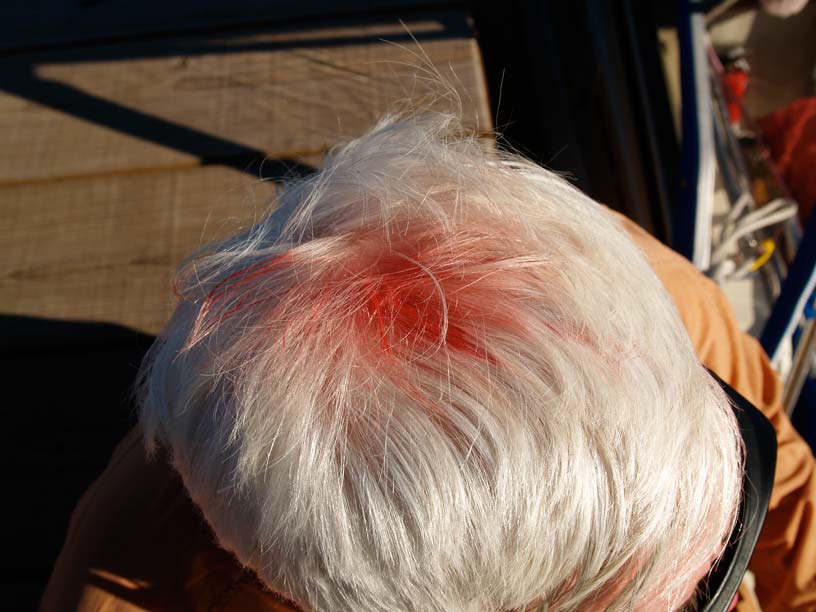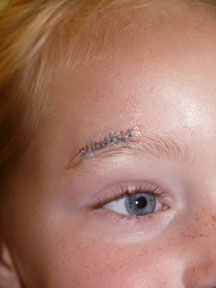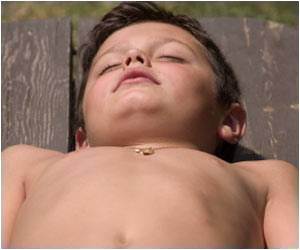Head Injury in Children
One afternoon next week you are aroused from the kitchen table, where you are sitting paying your bills, by some banging on your front room door. It is the neighbor boy who has come to tell you that your five-year-old son was just hit in the head with a rock and is crying.
Out of the corner of your eye you see the neighbors gawk out their windows as you run past in near panic – toward the circle of his friends all looking down to where he must be lying.
As you arrive on the scene you do see him on the ground crying, holding his head. And he seems nearly covered with blood.
Before you panic (any further), you decide that this time you will be calm, and collected. “What do I do?” “Do I call the paramedics?” “Do I take them to the Emergency Room?” “Do I need to see a doctor?” “Will he bleed to death?” “Will he have brain damage?”
A head injury can definitely be serious! But the fact is: the majority are not; and much money is wasted in Emergency Room visits for minor injuries.
But, on the other hand, unnecessary chances should not be taken with your child, and there has got to be a middle-of-the-road, common sense approach.
Lets look at some of the steps that you should take in your thinking while deciding upon the answers to the above questions about head injury.
Head Injury Steps: Stabilize
First: is the child unconscious or is there any chance of a significant injury to the neck? If so, Paramedics should be called and the child transported to the hospital.
Your child is crying (so he is not unconscious) and the mechanism of injury was a rock, so it is unlikely that he sustained a neck injury. Besides, ask him “does your neck hurt?”
 Secondly, is there anyone around who saw the accident? Was he at any time unconscious (knocked out)? If he was and is currently otherwise stable, you should contact your physician by phone and arrange to have him seen sometime within the next few hours.
Secondly, is there anyone around who saw the accident? Was he at any time unconscious (knocked out)? If he was and is currently otherwise stable, you should contact your physician by phone and arrange to have him seen sometime within the next few hours.
Notice I did not say rush him to the Emergency Room or convenience care center. All studies have shown that the most important thing to do in a previous history of unconsciousness is to have the child examined by a physician. Even more important than x-rays or brain wave tests.
The best person to do this is your child’s pediatrician who has seen him before and knows him.
Many children who have been knocked unconscious, but not all, are admitted to the hospital for observation of neurologic changes. Even if they are awake and seem well now.
And thirdly, is there significant bleeding; namely, is it pumping or squirting from an artery? if so, direct pressure should be applied over the wound and the child taken to the Emergency Room. There is almost always bleeding and lots of blood when there is an injury to the head, just because there are so many blood vessels. However, rarely is an artery breached requiring emergency first aid.
Making sure an injured person is breathing, conscious and not bleeding is the urgent “stabilization” part. Now you can take a breath and take your time to “assess” the damage and what your options are.
Assess
 The head is very vascular (full of little blood vessels) and bleeds very heavily from even the tiniest of scratches. The next thing to do in following your line of reasoning is to allow the child to put pressure over his “sore” and decide if you can take him home.
The head is very vascular (full of little blood vessels) and bleeds very heavily from even the tiniest of scratches. The next thing to do in following your line of reasoning is to allow the child to put pressure over his “sore” and decide if you can take him home.
If there has been no other associated injuries and he is awake, you can allow him to hold his “sore” and calmly go home.
After holding pressure on the cut for a few minutes, and kissing him better several times, gently wash the dirt and blood off with a wash rag.
You most frequently will be surprised to find that underneath all the blood was just a tiny scratch.
If you find, after cleaning him up with first aid soap, that there is a laceration whose edges do not fall together without help, you should call your physician for advice.
Treat
Many physicians, including myself, much prefer to suture the laceration closed themselves in our offices.
 Now that you have reached this far and are still at home, the decisions are still not through.
Now that you have reached this far and are still at home, the decisions are still not through.
In some injuries there is a risk of bleeding around the skull; either on the outside or the inside, next to the brain.
Almost all injuries will have a bruise which is observable. An ice pack will help the pain as well as the swelling. As long as the child is otherwise doing well, outside bruises are very rarely significant.
It’s the bruises and collection of blood on the inside of the skull that can become the problem. Mainly because they do the most damage and no one one can tell they are there, even the doctor, except by watching for early symptoms of pressure on the brain.
These are extremely rare unless the child has been knocked unconscious (that is why we admit those children to the hospital).
Monitor
After a head injury, you should keep your child at home and fairly quiet. Watching for any of the following signs: Severe headaches which persist (not just surface pain) and nausea and vomiting more than twice.
Many children will vomit once or twice and want to go to sleep after an injury. This is all right. However, if the child is becoming more and more sleepy or vomiting continues, then medical help should be sought.
If the pupils (black part in the middle of the eye) become unequal, there is weakness in an arm or leg, confusion or increasing depth of sleep like impending coma, medial help should also be sought.
Very small children may show the above mentioned signs by having prolonged inconsolable restlessness, fussiness, and crying.
Sedatives and narcotic medications should Not be given. If there is pain, nearly all physicians recommend acetaminophen.
Advertisement by Google
(sorry, only few pages have ads)

